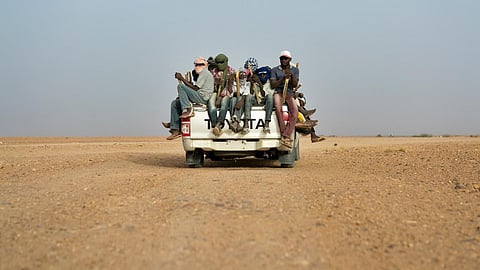

There’s a sense of excitement at the airport in Lagos, Nigeria. In the arrivals hall, migrants are seen returning from Libya, where conditions for migrants are widely known to be atrocious.
One of them is Felicity; her enthusiasm is almost palpable: “There is nothing better than home,” the 20-year-old Nigerian national says upon arrival. “Now we are back and safe. No one can look down on us anymore. We are happy.” Felicity had embarked on her dangerous journey through the Saharan desert in September 2020 already, hoping to reach Europe at any cost. But like thousands of other people, she eventually got stuck in Libya, which for much of the past decade has become the main country of departure for migrants undertaking the expensive - and perilous -crossing to Europe.
Many, however, don’t even get anywhere near there. In Libya, migrants are known to be brutally abused by criminal gangs, struggling to survive. The actual number of those who die under inhumane conditions of captivity, servitude or violence is unknown. Felicity managed to get by with odd jobs for more than two years. But in the end, she says she just wanted to get away.
In the past three years, according to the United Nations, a total of 13,000 Nigerians have voluntarily returned to their home country with the help of Nigerian government authorities and the International Organization for Migration (IOM).
Their dream of a better life in Europe has turned into a nightmare, forced to experience violence, abuse and racism in Libya. “The biggest challenge is the mental health of the migrants,” says Victor Lutenco, IOM staff member at the transit center, where returnees are registered upon arrival. “In addition to material support, psychosocial assistance is our priority.” But these are the images that many people don’t see or know when they engage in discussions about migration. The emphasis in such public debates is usually placed firmly on people on small rubber dinghies suffering shipwreck while trying to cross the Mediterranean Sea. However in truth, the majority of migration narratives featuring Africans actually take place on their own continent: according to the IOM, around 21 million Africans lived in another African country in 2020. In comparison, the number of Africans living in other regions of the world stood at over 19.5 million the same year.
More than 70% of migratory movements within Africa take place within West Africa alone, according to the IOM. Many people search for better work opportunities. However, in recent years, irregular migration from sub-Saharan Africa to Europe as well as between West and Central Africa has also increased significantly. However, as migration patterns increase, so do deportations in many regions. Transit countries are increasingly overwhelmed with the influx of migrants. One of the leading countries carrying out mass deportations is Algeria.
Between January and the end of March 2023, the North African nation has sent more than 10,000 migrants back to the desert region along its border with Niger, reports the activist network Alarme Phone Sahara (APS), which advocates for migrants and refugees in the Sahel.
According to Moctar Dan Yaye, one of the founding members and Head of Communications and PR at APS, deportation activities to this no-man’s land can be divided into two categories: official and unofficial ones. In the so-called “official” deportations, the main nationals affected are Nigeriens; on the basis of an agreement between Niger and Algeria, Nigeriens are taken directly to the small border town of Assamaka, from where they are then transported to Arlit or Agadez by Nigerien authorities.
This article was provided by Deutsche Welle
Visit news.dtnext.in to explore our interactive epaper!
Download the DT Next app for more exciting features!
Click here for iOS
Click here for Android